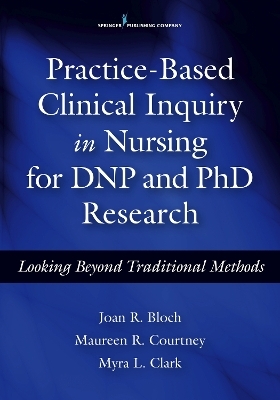
Practice-Based Clinical Inquiry in Nursing
Springer Publishing Co Inc (Verlag)
978-0-8261-2694-8 (ISBN)
Meticulously compiled to serve the specific needs of APRNs and nurse executives engaged in doctoral-level research, this text provides evidence-based and practice-based scholarly methods not traditionally taught in PhD or DNP programs. Building on and expanding traditional nursing research methods, the bookfocuses on both existing and evolving methods of clinical inquiry, some of which incorporate technology and knowledge from other disciplines. These areapproaches that can be translated into clinical practice, providing the nursing profession with unprecedented opportunities for collaboration in improvinghealth and health care systems. Methods include quality improvement, implementation science, logic models, program planning and evaluation, patient-engaged and community participatory research, dissemination research, big data, comparative effectiveness research, secondary analysis, and systematic reviews.
Chapters provide clear guidance on why and how to use a particular method, and are consistently organized to enable a comparison and contrast of different approaches in order to select the one that best fits a particular research need. The text highlights the importance of each approach, and discusses why touse a particular method for doctoral nursing work. Chapters describe how to apply the method along with how to interpret findings and disseminate them. Thedescription of each method concludes with examples from the published literature. Practical tips for impact and success in research and program proposals increase the text value.
Key Features:
Presents research methods specifically for doctoral-level evidence-based and practice-based clinical research
Describes interdisciplinary health care methodologies focused on evidence-based improvement in health care
Offers practical information on benefits and use of each method
Provides examples of each method from published literature
Written by experienced academic and practice scholars from across the United States
Joan R. Bloch, PhD, CRNP, is associate professor of nursing, and has held secondary appointments as associate professor of Nutritional Science and Public Health at Drexel University. Maureen R. Courtney, PhD, APRN, FNP-BC, is associate professor, University of Texas at Arlington College of Nursing and Health Innovation. Myra L. Clark, PhD, RN, FNP-C, is associate professor, the FNP program, The University of North Georgia. She is the director of research for the College of Health Sciences and Professions at The University of North Georgia.
CONTENTS
Contributors
Preface
Acknowledgments
PART I: EXISTING PRACTICE-BASED METHODS FOR CLINICAL INQUIRY
1. Health Program Planning and Evaluation: What Nurse Scholars Need to Know
L. Michele Issel
Objectives
The Public Health Pyramid and Health Programs
Rationale for Utilizing Program Planning and Evaluation Approaches
Methods for Program Planning and Evaluation
Interpretation and Presentation of Scholarship Pertaining to Program Planning and Evaluation
2. Patient-Engaged and Community-Based Participatory Research
Bonnie Jerome-D’Emilia and Kathleen J. Jackson
Objectives
Purpose of PAR
Description of PAR
Importance of PEPR and CBPR
Methods of Creating PEPR and CBPR
The Interpretation and Presentation of PEPR and CBPR
Considerations: Challenges and Ethical Issues in PEPR and CBPR
Examples of Published PEPR and CBPR
3. Systematic Reviews
Susan Weber Buchholz, Denise M. Linton, Maureen R. Courtney, and Michael E. Schoeny
Objectives
The Importance of Systematic Reviews
Three Important Reasons for Systematic Reviews
Conducting a Systematic Review
Interpretation and Presentation of Systematic Reviews
Appraisal of Systematic Reviews
Appendix 3.1 Systematic Review Resources
Appendix 3.2 Examples of Systematic Review Abstracts From the Published Literature
4. Quality Improvement Research
Catherine Johnson, Mary Ellen Smith Glasgow, and Mary Elizabeth “Betsy” Guimond
Objectives
The Importance of Quality Improvement
Reasons Why Nurse Scholars Should Use Quality Improvement Research Approaches
Methods for Quality Improvement Research
Models for Quality Improvement Developed in Health Care
PhD/DNP Model of Collaboration for Quality Improvement in Health Care
PART II: EVOLVING PRACTICE-BASED RESEARCH METHODS
5. Big Data in Nursing Research
Patricia Abbott and Boqin Xie
Objectives
Defining Big Data and Analytics
Big Data in Nursing Inquiry
Methods, Tools, and Processes Used With Big Data With Relevance to Nursing
Examples From the Published Literature
6. Comparative Effectiveness Research
Georgia L. Narsavage
Objectives
Description of CER
Reasons for Using CER
Methods of Creating CER
Interpretation of CER
The Presentation of CER
Appendix 6.1 Comparative Effectiveness Resources
Appendix 6.2 Examples of CER Abstracts From the Published Literature
7. Dissemination Research
Jane T. Garvin, Amber B. McCall, and Devita T. Stallings
Objectives
Defining Dissemination Research
Importance of Dissemination Research
Methods of Creating Dissemination Research
Analysis of Data Related to Dissemination Research
Interpretation and Presentation of Dissemination Research
Examples of Published Dissemination Research
8. Implementation Research
Joan R. Bloch, Myra L. Clark, and Judy Faust
Objectives
Why Nurse Scholars Should Use Implementation Science in Research and Practice
How to Use Implementation Science
The Interpretation and Presentation of Implementation Research
PART III: A TOOLBOX FOR GREATER IMPACT AND SUCCESS
9. Using Geographic Information Systems in Clinical and Population Health Research
Joan R. Bloch and Sarah Cordivano
Objectives
Geographic Information Systems
Reasons Why GIS Is Important for Practice-Based Clinical Inquiry
How to Use GIS in Nursing Clinical Inquiry Research
Examples of Published Literature
10. A Statistical Toolbox: Tips for Engaging in Clinical Inquiry to Improve Health and Health Care
Louis Fogg, Beth A. Staffileno, and Marcia Murphy
Objectives
The Statistical Toolbox
Working With Statisticians: What Nurse Scholars Need to Know
Conclusion With Words of Wisdom From the Statistician Himself
11. Logic Models
Shirlee M. Drayton-Brooks, Paula Gray, and Maria Elayne DeSimone
Objectives
Logic Model Defined
The Importance of Logic Models
Reasons for Using Logic Models
Methods of Creating Logic Models
Presentation of Theory-Driven Logic Models
Index
| Erscheinungsdatum | 02.03.2016 |
|---|---|
| Verlagsort | New York |
| Sprache | englisch |
| Maße | 178 x 254 mm |
| Themenwelt | Schulbuch / Wörterbuch ► Lexikon / Chroniken |
| Pflege ► Studiengänge ► Pflegewissenschaft | |
| ISBN-10 | 0-8261-2694-4 / 0826126944 |
| ISBN-13 | 978-0-8261-2694-8 / 9780826126948 |
| Zustand | Neuware |
| Haben Sie eine Frage zum Produkt? |
aus dem Bereich


